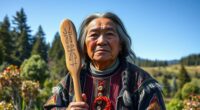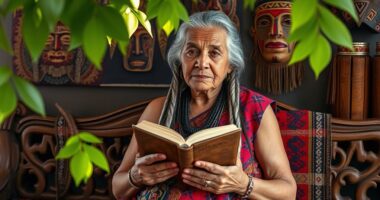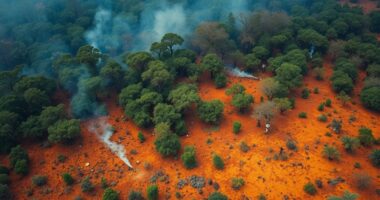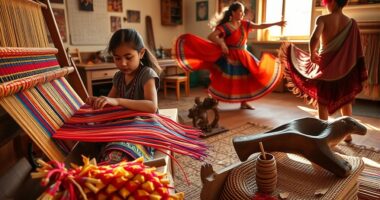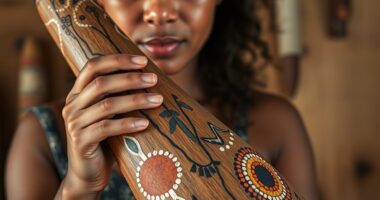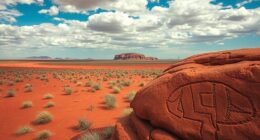Bark painting from Northern Australia showcases vibrant indigenous art that uses symbolic imagery and storytelling techniques. Artists carve or paint on tree bark, creating designs that depict animals, waterholes, and sacred sites. These works serve as visual languages to share cultural stories, spiritual beliefs, and land connections. The themes help preserve traditions and strengthen community identity. If you explore further, you’ll uncover more about the rich techniques and meaningful symbolism behind these extraordinary artworks.
Key Takeaways
- Northern Australian bark paintings are created by transforming tree bark into vibrant artworks using traditional painting techniques.
- Artists employ symbolic motifs representing animals, waterholes, and sacred sites to tell cultural stories.
- Techniques often involve natural materials like ochre, charcoal, and plant dyes applied with brushes or fingers.
- Themes focus on land, ancestors, spiritual beliefs, and environmental elements central to Indigenous culture.
- Bark paintings serve as a visual language for storytelling, cultural preservation, and passing down traditions across generations.

Bark painting is a traditional art form that transforms the natural surface of tree bark into vibrant, expressive artworks. When you observe these paintings, you’ll notice they’re more than just decorations—they’re rich stories woven into each brushstroke. The symbolism in bark painting plays a pivotal role in conveying messages about the land, ancestors, and spiritual beliefs. Each symbol has specific meanings, often representing animals, waterholes, or sacred sites, which are integral to the community’s understanding of their world. These symbols aren’t random; they encode complex cultural knowledge passed down through generations, linking the past with the present. As you explore this art form, you’ll see how these symbols serve as a visual language, allowing Indigenous artists to communicate stories and teachings that might otherwise be lost.
Bark paintings aren’t just about aesthetics—they’re an essential means of preserving indigenous culture. When you witness these artworks, you’re engaging with living traditions that have endured for thousands of years. The act of creating these paintings is a way for communities to keep their history alive, especially in a world where many Indigenous practices face threats from modernization and cultural erosion. Every painting bears the mark of ancestral knowledge, ensuring that traditions are carried forward, even as languages and customs change. Cultural preservation is a fundamental aspect of bark painting, helping to maintain the continuity of Indigenous identity and heritage. This preservation of indigenous culture through art fosters a sense of identity and pride, connecting communities to their ancestors and to the land itself. It’s a powerful reminder that culture isn’t static but actively maintained through storytelling, ritual, and artistic expression.
Frequently Asked Questions
How Do Indigenous Artists Preserve Traditional Bark Painting Techniques?
You preserve traditional bark painting techniques by actively practicing and passing them down through cultural preservation efforts. Indigenous artists stick to traditional methods, like using natural pigments and specific brush strokes, to maintain authenticity. They teach younger generations, share stories behind each design, and participate in community workshops. This hands-on approach guarantees that the techniques remain alive, honoring their cultural heritage and keeping their art forms vibrant for future generations.
What Are the Common Symbols and Motifs Used in Bark Paintings?
You’ll notice that most bark paintings feature Dreamtime symbols and animal motifs, which hold deep cultural meanings. Around 80% of these artworks depict ancestral stories using intricate symbols like concentric circles, wavy lines, and cross-hatching. These motifs represent elements like waterholes, animals, and spiritual beings, helping to preserve stories and traditions. By recognizing these symbols, you gain insight into the rich spiritual and cultural beliefs of Indigenous Australians.
How Has Bark Painting Evolved With Modern Art Influences?
You’ll notice that bark painting has evolved through contemporary adaptations and urban influences, blending traditional methods with modern aesthetics. Artists incorporate new symbols, vibrant colors, and mixed media to reflect current experiences, making the art more accessible and relevant. This evolution allows you to see how cultural stories adapt to contemporary contexts, maintaining their significance while embracing innovation. Urban influences inspire fresh perspectives, enriching the enduring legacy of bark painting.
Are There Specific Ceremonies Associated With Creating Bark Paintings?
You might think creating bark paintings is just art, but it’s often deeply tied to ceremonial significance. Ritual practices may involve sacred symbols or stories passed down through generations, making each piece more than just decoration. Sometimes, these artworks are part of initiation ceremonies or community rituals, highlighting their spiritual importance. So, yes, creating bark paintings can be a sacred act, blending artistic expression with cultural and spiritual rituals.
How Can Viewers Interpret the Stories Depicted in Bark Paintings?
You can interpret the stories in bark paintings by paying attention to Dream symbolism and storytelling interpretations. Look for recurring symbols and patterns, which often represent sacred narratives or ancestral beings. Consider the cultural context, as these paintings serve as visual stories passed down through generations. By understanding Dream symbolism, you’ll gain insight into the spiritual meanings and cultural messages conveyed, deepening your appreciation of the artwork’s significance.
Conclusion
You now see how bark painting captures stories, preserves culture, and reflects tradition. You understand the intricate techniques, the vibrant themes, and the deep connection to land and spirituality. You recognize the importance of respecting these art forms, appreciating their beauty, and sharing their messages. By embracing these practices, you honor the past, celebrate the present, and inspire the future. You carry this knowledge forward, keeping the spirit of northern Australian bark painting alive and thriving.
Mary is a passionate writer who brings creativity and a fresh perspective to our team. Her words have the power to captivate and inspire, making her an essential contributor to our content. Mary’s commitment to storytelling and dedication to promoting Indigenous culture ensures that her work touches the hearts of our readers. We’re fortunate to have her as part of our team.

